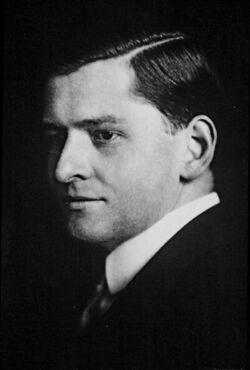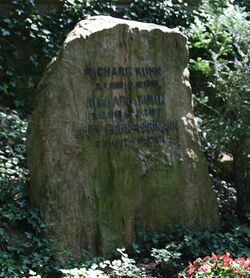Richard Kuhn
Topic: Biography
 From HandWiki - Reading time: 5 min
From HandWiki - Reading time: 5 min
Richard Kuhn | |
|---|---|
 | |
| Born | Richard Johann Kuhn 3 December 1900 |
| Died | 31 July 1967 (aged 66) Heidelberg, West Germany |
| Nationality | Germany, Austria |
| Alma mater | University of Vienna University of Munich |
| Known for | Carotenoids and Vitamins[1] Isoalloxazine Total synthesis of riboflavin and Vitamin B6 Soman Kuhn–Winterstein reaction |
| Awards |
|
| Scientific career | |
| Fields | Chemistry |
| Institutions | University of Heidelberg |
Richard Johann Kuhn (German pronunciation: [ˈʁɪçaʁt ˈkuːn] (![]() listen); 3 December 1900 – 31 July 1967) was an Austrian-German biochemist who was awarded the Nobel Prize in Chemistry in 1938 "for his work on carotenoids and vitamins".
listen); 3 December 1900 – 31 July 1967) was an Austrian-German biochemist who was awarded the Nobel Prize in Chemistry in 1938 "for his work on carotenoids and vitamins".
Biography
Early life
Kuhn was born in Vienna, Austria, where he attended grammar school and high school. His interest in chemistry surfaced early; however he had many interests and decided late to study chemistry. Between 1910 and 1918 he was a schoolmate of Wolfgang Pauli, who was awarded the Nobel Prize in Physics for 1945. Beginning in 1918, Kuhn attended lectures at the University of Vienna in chemistry. He finished his chemistry studies at University of Munich and received his doctoral degree in 1922 with Richard Willstätter for a scientific work on enzymes.
After graduating, Kuhn continued his scientific career, first in Munich, then at the ETH Zurich and from 1929 onwards at the University of Heidelberg, where he was head of the chemistry department beginning in 1937. In 1928 he married Daisy Hartmann and the couple subsequently had two sons and four daughters.
Research
Kuhn's areas of study included: investigations of theoretical problems of organic chemistry (stereochemistry of aliphatic and aromatic compounds; syntheses of polyenes and cumulenes; constitution and colour; the acidity of hydrocarbons), as well as extensive fields in biochemistry (carotenoids; flavins; vitamins and enzymes). Specifically, he carried out important work on vitamin B2 and the antidermatitis vitamin B6.
In 1929 he became Principal of the Institute for Chemistry at the newly founded Kaiser Wilhelm Institute for Medical Research (which, since 1950, has been renamed the Max Planck Institute for Medical Research in Heidelberg). By 1937 he also took over the administration of this Institute.
In addition to these duties he also served as of Professor of Biochemistry at the University of Heidelberg, and for one year he was at the University of Pennsylvania, Philadelphia, as a Visiting Research Professor for Physiological Chemistry.
He was subsequently awarded the Nobel Prize in Chemistry in 1938 for his "work on carotenoids and vitamins," but rejected the prize as Hitler had forbidden German citizens to accept it. In a hand-written letter, he even described the awarding of the prize to a German as an invitation to violate a decree of the Führer.[2][3] He received the award after World War II.[4] Kuhn is also credited with the discovery of the deadly nerve agent Soman in 1944.[5]
Kuhn was editor of Justus Liebigs Annalen der Chemie from 1948.
Kuhn died in 1967 in Heidelberg, Germany, aged 66.
Nazi era
Kuhn collaborated with high-ranking Nazi officials[6] and denounced three of his Jewish co-workers in 1936.[6]
In 2005, the Society of German Chemists (Gesellschaft Deutscher Chemiker, GDCh) declared their intention to no longer award the Richard Kuhn Medal: "The board of the GDCh intends to discontinue awarding the Medal named after the organic chemist, Nobel Prize laureate of the year 1938 and President of the GDCh in 1964–65, Richard Kuhn. The board thereby draws the consequences out of research on Richard Kuhn's behaviour during National Socialism. Even though the question of whether Kuhn was a convinced National Socialist or just a career-oriented camp follower is not fully answered, he undisputably supported the Nazi-regime in administrative and organizational ways, especially by his scientific work. Despite his scientific achievements, Kuhn is not suitable to serve as a role model, and eponym for an important award, mainly due to his unreflected research on poison gas, but also due to his conduct towards Jewish colleagues."[7]
Honours and awards
- 1938: Nobel Prize in Chemistry
- 1952: Wilhelm Exner Medal
- 1960: Honorary doctorate from the University of Vienna
- 1961: Austrian Decoration for Science and Art
References
- ↑ "The Nobel Prize in Chemistry 1938". https://www.nobelprize.org/prizes/chemistry/1938/kuhn/biographical/.
- ↑ U. Deichmann, "Dem Duce, dem Tenno und unserem Führer ein dreifaches Heil", published in D. Hoffmann and Mark Walker (eds.), "Physiker zwischen Autonomie und Anpassung" (Weinheim: Wiley-VCH Verlag, 2006).
- ↑ Sarah Everts, Chemistry In Nazi Germany, Chemical & Engineering News, Volume 91, Issue 37, pp. 30–33, 16 September 2013, American Chemical Society.
- ↑ "Nobel Laureates Facts". The Nobel Foundation. 2008. https://www.nobelprize.org/nobel_prizes/facts/.
- ↑ Lukey, Brian J.; Salem, Harry (2007). Chemical Warfare Agents: Chemistry, Pharmacology, Toxicology, and Therapeutics. CRC Press. pp. 12. ISBN 978-1-4200-4661-8.
- ↑ 6.0 6.1 "Science in the Third Reich", Margit Szöllösi-Janze. Berg Publishers, 2001. ISBN:1-85973-421-9, ISBN:978-1-85973-421-6. Retrieved 16 March 2010.
- ↑ Nachrichten aus der Chemie. 54: 514. May 2006.
- Shampo, M. A.; Kyle R A (October 2000). "Richard Kuhn – Nobel Prize for work on carotenoids and vitamins". Mayo Clin. Proc. 75 (10): 990. doi:10.4065/75.10.990. ISSN 0025-6196. PMID 11040844.
- Baer, H. H. (1969). Richard Kuhn; 1900–1967. Advances in Carbohydrate Chemistry and Biochemistry. 24. pp. 1–12. doi:10.1016/S0065-2318(08)60347-9. ISBN 978-0-12-007224-8.[this reference does not seem to say what it is claimed to]
External links
- Grandin, Karl, ed (1938). "Richard Kuhn Biography". Les Prix Nobel. The Nobel Foundation. http://nobelprize.org/nobel_prizes/chemistry/laureates/1938/kuhn-bio.html.
- 1938 Nobel Prize in Chemistry
- Miss nobel-id as parameter
 |
 KSF
KSF

